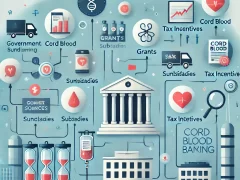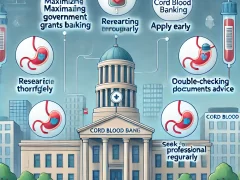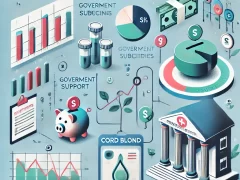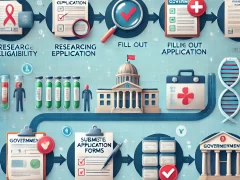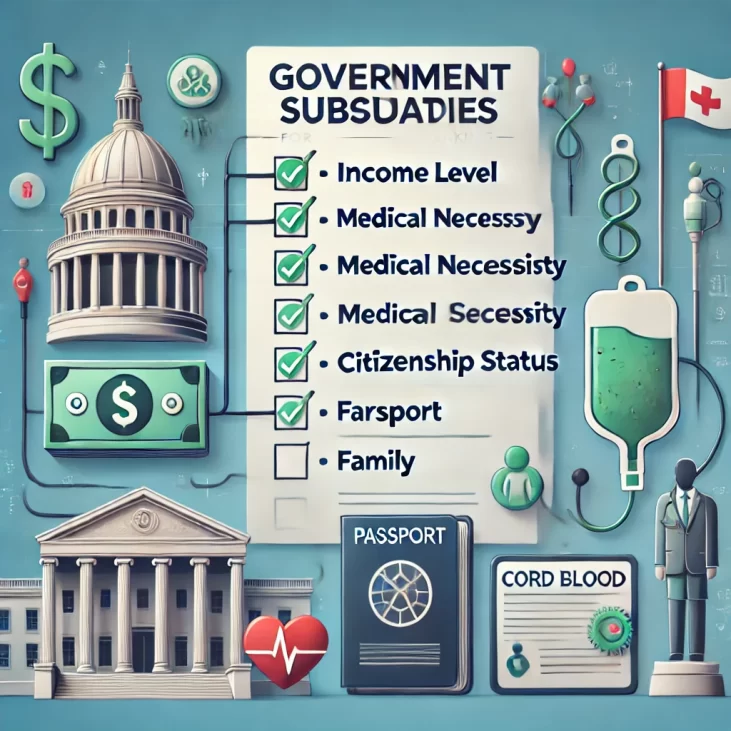
Qualifying Criteria for Government Subsidies in Cord Blood Banking
Here is the article on “Qualifying Criteria for Government Subsidies in Cord Blood Banking” with the requested specifications:
Cord blood banking has become an increasingly vital part of healthcare, offering a valuable source of stem cells for potential medical treatments. However, the costs associated with cord blood banking can be a significant barrier for many families. Fortunately, some governments offer subsidies and financial assistance programs to help alleviate these expenses. In this article, we’ll explore the qualifying criteria for these government subsidies and provide insights into how families can access this valuable support.
Understanding the Importance of Cord Blood Banking
Cord blood is the blood that remains in the umbilical cord and placenta after a baby is born. This blood is a rich source of hematopoietic stem cells, which can be used to treat a variety of medical conditions, including certain types of cancer, blood disorders, and immune system diseases. By storing this cord blood, families can ensure that these valuable cells are available for potential future medical needs.
Eligibility Criteria for Government Subsidies
The specific eligibility criteria for government subsidies in cord blood banking can vary widely depending on the country and even the region within a country. However, there are some common factors that are typically considered:
Household Income: Many government subsidy programs are means-tested, which means that they are only available to families that meet certain income thresholds. This ensures that the financial assistance is directed towards those who need it the most.
Residency Status: Eligibility for government subsidies often depends on the family’s residency status. This may include factors such as citizenship, permanent residency, or length of time living within the country or region.
Medical Conditions: Some government subsidies are specifically designed to support families whose children have pre-existing medical conditions that may benefit from cord blood banking. These programs may have additional eligibility requirements related to the child’s health.
Newborn Status: In some cases, government subsidies are only available for newborns, as the cord blood must be collected immediately after birth to be suitable for banking and potential future use.
Timing of Application: Families may need to apply for government subsidies within a specific timeframe, such as during the pregnancy or shortly after the child’s birth, to be eligible for the financial assistance.
Once families have determined their eligibility for government subsidies in cord blood banking, the next step is to navigate the application process. This can vary greatly depending on the specific program, but often involves the following steps:
Gathering Required Documentation: Families may need to provide proof of income, residency status, and other relevant information to demonstrate their eligibility for the subsidy program.
Submitting the Application: The application process may involve submitting forms, either online or through physical mail, to the appropriate government agency or program administrator.
Awaiting Approval: The review and approval process for government subsidies can take time, so families should be prepared to wait patiently for a decision on their application.
Ongoing Compliance: If approved for the subsidy, families may need to fulfill ongoing requirements, such as maintaining their financial or residency status, to continue receiving the support.
Government subsidies can play a crucial role in making cord blood banking accessible to families who might otherwise be unable to afford the associated costs. By understanding the eligibility criteria and navigating the application process, families can take advantage of this valuable financial assistance and ensure that their child’s cord blood is properly stored and available for potential future medical needs.
Importance of Cord Blood Preservation and its Benefits
The Lifesaving Potential of Cord Blood Preservation
Cord blood, the blood found in the umbilical cord and placenta, has gained significant attention in recent years due to its remarkable medical applications. This precious resource, once discarded as medical waste, is now recognized as a valuable source of stem cells that can be used to treat a wide range of diseases and disorders.
The Science Behind Cord Blood Stem Cells
Cord blood contains a rich supply of hematopoietic stem cells, which are capable of developing into various types of blood cells, including red blood cells, white blood cells, and platelets. These stem cells are unique in their ability to self-renew and differentiate, making them highly valuable in the field of regenerative medicine.
The Therapeutic Applications of Cord Blood
The potential of cord blood stem cells has led to their use in the treatment of numerous medical conditions. Stem cell transplants using cord blood have been successful in treating various blood disorders, such as leukemia, lymphoma, and sickle cell disease. Additionally, researchers are exploring the use of cord blood stem cells in the treatment of neurological conditions, including cerebral palsy and autism, as well as in the regeneration of damaged tissues and organs.
The Importance of Cord Blood Preservation
Given the immense therapeutic value of cord blood, preserving it for potential future use has become increasingly important. By storing cord blood in a cord blood bank, parents can ensure that this valuable resource is available if their child or a family member ever requires a stem cell transplant. Additionally, preserved cord blood can be donated to help others in need, contributing to the growing pool of stem cell therapies available to the public.
The Financial Consideration of Cord Blood Preservation
The cost of cord blood banking can be a significant factor for many families. However, it is essential to weigh the potential benefits against the financial investment. Some governments and healthcare systems offer subsidies or financial assistance programs to help make cord blood preservation more accessible to families. Understanding the qualifying criteria for these programs can be crucial in making an informed decision about cord blood banking.
Cord blood preservation is a remarkable medical advancement that holds the promise of saving lives and improving the quality of life for those affected by various health conditions. By understanding the science behind cord blood stem cells, the therapeutic applications, and the financial considerations, families can make an informed decision about preserving this valuable resource for the future.
Financial Considerations for Families Seeking Cord Blood Banking
Qualifying Criteria for Government Subsidies for Cord Blood Banking
When it comes to cord blood banking, families may be eligible for government subsidies to help offset the cost. These subsidies can make a significant difference in the overall financial burden of storing cord blood, making it a more accessible option for families from all socioeconomic backgrounds. However, the qualifying criteria for these subsidies can vary depending on the location and specific program, so it’s important for families to research and understand the requirements in their area.
Understanding the Benefits of Cord Blood Banking
Cord blood banking is a process where the blood from a newborn’s umbilical cord is collected, processed, and stored for potential future medical use. This blood is rich in stem cells, which have the ability to develop into various cell types and can be used to treat a range of conditions, including blood disorders, immune system disorders, and certain types of cancer.
The decision to bank cord blood can be a significant financial investment, but the potential benefits make it a valuable consideration for many families. Cord blood banking can provide a personal source of stem cells that can be used for the child or a close family member if needed, and it can also be donated to public banks for use by others in need.
Eligibility Criteria for Government Subsidies
To qualify for government subsidies for cord blood banking, families may need to meet certain criteria. These can include:
- Income Thresholds: Many government programs have income-based eligibility requirements, with families below a certain income level qualifying for financial assistance.
- Medical Conditions: Some subsidies are specifically targeted towards families with a history of genetic or medical conditions that could be treated by cord blood stem cells.
- Geographical Location: The availability and eligibility criteria for government subsidies can vary significantly by region or state, so families should research the specific programs in their area.
- Enrollment Deadlines: Families may need to enroll in the subsidy program within a certain timeframe, often during the pregnancy or shortly after the child’s birth.
Applying for government subsidies for cord blood banking can involve several steps, so it’s important for families to be prepared and organized. This may include:
- Researching Eligible Programs: Families should investigate the various government-funded programs in their area and understand the specific requirements for each one.
- Gathering Necessary Documentation: Applicants may need to provide proof of income, medical history, or other relevant information to demonstrate their eligibility.
- Submitting the Application: The application process may involve completing forms, submitting supporting documents, and meeting any deadlines or other requirements.
- Monitoring the Status: Families should be prepared to follow up on their application and respond to any requests for additional information or documentation.
By understanding the qualifying criteria and navigating the application process, families can take advantage of government subsidies to make cord blood banking a more accessible and affordable option for their loved ones.
Eligibility Criteria for Cord Blood Banking Subsidies
When it comes to securing government subsidies for cord blood banking, understanding the eligibility criteria is crucial. These subsidies can provide significant financial relief to families who wish to preserve their child’s cord blood for potential medical use in the future. Let’s explore the key factors that determine whether you qualify for these valuable programs.
Income Thresholds and Household Size
One of the primary factors in determining eligibility for cord blood banking subsidies is your household income. Many government-sponsored programs set income thresholds based on factors like the number of people in your household. For example, a family of four may be eligible for subsidies if their annual income falls below a certain limit, while a single-person household may have a different threshold. Carefully reviewing the specific income guidelines for the program you’re interested in is essential.
Health Insurance Coverage
The availability of health insurance coverage can also play a role in qualifying for cord blood banking subsidies. Some programs may prioritize families with limited or no health insurance, as they are more likely to face financial barriers to accessing cord blood banking services. If you have comprehensive health insurance, you may still be eligible, but the level of subsidy may be lower compared to those without coverage.
Residency and Citizenship Requirements
Geographical location and citizenship status can also impact your eligibility for cord blood banking subsidies. Many programs are tailored to residents of specific states or regions, and some may have additional requirements related to citizenship or immigration status. Ensure that you meet the residency and citizenship criteria outlined by the program you’re considering.
Timing of Application Submission
The timing of your application for cord blood banking subsidies can also be a crucial factor. Some programs may have specific enrollment periods or deadlines, so it’s essential to stay informed about the application process and submit your paperwork within the required timeframe. Failure to do so could result in your application being denied or delayed.
Qualifying Cord Blood Banking Services
It’s important to note that not all cord blood banking services may be eligible for government subsidies. Many programs have specific requirements regarding the cord blood banking facility, the collection and storage methods, and the types of services provided. Be sure to research the approved providers and services that are covered under the subsidy program you’re interested in.
Once you’ve determined that you meet the eligibility criteria, the next step is to navigate the application process. This may involve gathering various documents, such as proof of income, health insurance information, and residency verification. Additionally, you may need to provide detailed information about the cord blood banking services you plan to use. Being organized and thorough in your application can increase your chances of successfully securing the available subsidies.
Understanding the qualifying criteria for government subsidies for cord blood banking is essential for families who wish to preserve their child’s cord blood. By familiarizing yourself with the income thresholds, insurance coverage requirements, residency guidelines, and the application process, you can maximize your chances of obtaining the financial support needed to make this important investment in your child’s future health.
Emerging Trends and Future Outlook of Government Support for Cord Blood Preservation
The Evolving Landscape of Government Support for Cord Blood Preservation
Cord blood banking has emerged as a vital component of modern healthcare, offering a unique source of stem cells for potential medical treatments. As the field continues to evolve, the role of government support has become increasingly crucial in ensuring accessible and sustainable cord blood preservation programs.
Factors Driving Government Involvement
Governments worldwide have recognized the significant benefits of cord blood banking, leading to a growing trend of financial and regulatory support. Several key factors have contributed to this increasing involvement:
Public Health Considerations: Cord blood stem cells have shown promise in the treatment of a wide range of medical conditions, from blood disorders to regenerative therapies. Governments are keen to invest in initiatives that can enhance public health outcomes and improve access to these potentially life-saving treatments.
Expanding Research and Clinical Applications: As the scientific understanding of cord blood stem cells continues to deepen, the range of therapeutic applications has expanded. Governments are eager to foster research and development in this field, recognizing the long-term benefits for their healthcare systems.
Equity and Accessibility: Ensuring equitable access to cord blood banking services is a growing priority for many governments. By providing financial assistance or subsidies, they aim to make cord blood preservation accessible to a broader population, regardless of socioeconomic status.
Government Funding and Subsidy Programs
Governments around the world have implemented various funding and subsidy programs to support cord blood banking. These initiatives often include:
Direct Subsidies: Some governments offer direct financial subsidies to individuals or families to offset the cost of cord blood banking. This helps to make the service more affordable and encourages higher participation rates.
Public Cord Blood Banks: Certain governments have established publicly-funded cord blood banks, providing storage and preservation services at no or low cost to eligible citizens. This approach ensures a reliable supply of cord blood units for both public and private use.
Research and Development Grants: Governments often provide grants and funding to support research initiatives focused on expanding the clinical applications of cord blood stem cells. This investment helps to drive innovation and progress in the field.
Regulatory Frameworks: Governments play a crucial role in establishing regulatory frameworks to ensure the safety, quality, and ethical practices of cord blood banking. These guidelines help to build public trust and confidence in the industry.
Emerging Trends and Future Outlook
As the demand for cord blood banking services continues to grow, governments are likely to increase their involvement and support in the coming years. Some emerging trends and potential future developments include:
Expanding Eligibility Criteria: Governments may broaden the eligibility criteria for their subsidy and funding programs, making cord blood banking more accessible to a larger segment of the population.
Integrated Public-Private Partnerships: Governments may explore collaborative models that integrate public and private cord blood banking services, leveraging the strengths of both sectors to enhance accessibility and service quality.
Technological Advancements: Governments may invest in supporting the development of advanced cord blood processing and storage technologies, improving the efficiency and longevity of preserved stem cells.
Coordinated International Efforts: Increasing international collaboration and harmonization of regulations may lead to more comprehensive and coordinated global efforts to support cord blood banking and its therapeutic applications.
As the landscape of government support for cord blood preservation continues to evolve, it is clear that these initiatives will play a pivotal role in shaping the future of this critical healthcare service. By fostering innovation, ensuring accessibility, and promoting research, governments can help unlock the full potential of cord blood stem cells and their transformative impact on modern medicine.
Conclusion
Cord blood banking has emerged as a vital aspect of modern healthcare, providing families with the opportunity to preserve a valuable biological resource for potential future medical needs. The availability of government subsidies for cord blood banking has made this option more accessible, particularly for those facing financial constraints. By understanding the qualifying criteria, navigating the application process, and considering the wider implications of cord blood preservation, families can make informed decisions that align with their healthcare priorities and financial considerations.
The qualifying criteria for government subsidies in cord blood banking often encompass factors such as household income, medical history, and the intended use of the preserved cord blood. Families who meet the established thresholds may be eligible for partial or full coverage of the costs associated with cord blood collection, processing, and storage. This financial support can be a game-changer, enabling more families to take advantage of the potential benefits of cord blood banking.
The importance of cord blood preservation cannot be overstated. Cord blood is a rich source of stem cells, which can be utilized in the treatment of a wide range of medical conditions, from blood disorders and immune system deficiencies to certain types of cancer. By preserving this valuable resource, families can have access to a personalized source of stem cells, should the need arise. Furthermore, the stored cord blood can potentially benefit not only the child but also other family members, expanding the scope of its medical applications.
For families considering cord blood banking, the financial implications are a crucial factor. The costs associated with this service can be significant, and the availability of government subsidies can make a substantial difference in the overall affordability. By understanding the various financial considerations, such as the initial collection and processing fees, ongoing storage costs, and potential insurance coverage, families can make more informed decisions and plan accordingly.
The application process for cord blood banking subsidies can be navigated with the guidance of healthcare professionals and government agencies. Familiarizing oneself with the required documentation, eligibility criteria, and submission timelines can help ensure a smooth and successful application. By proactively seeking out information and support, families can maximize their chances of securing the financial assistance they need to preserve this invaluable biological resource.
Looking to the future, the trends and outlook for government support in cord blood preservation suggest a growing recognition of its importance. As the scientific and medical community continues to uncover new applications for cord blood stem cells, governments may be inclined to expand their subsidies and incentives for families to participate in cord blood banking programs. This could lead to increased accessibility, greater affordability, and more comprehensive coverage for those seeking to preserve this potentially life-saving resource.
The availability of government subsidies for cord blood banking has opened up new opportunities for families to safeguard the health and well-being of their children and loved ones. By understanding the qualifying criteria, navigating the application process, and considering the broader implications of cord blood preservation, families can make informed decisions that align with their healthcare priorities and financial capabilities. As the field of cord blood banking continues to evolve, the future holds the promise of even greater accessibility and support, ensuring that this valuable biological resource remains within reach for a growing number of families.




